rambled around the north of Ireland searching
for traces of my Irish ancestors. Here is but
a sample of what we saw along the way.
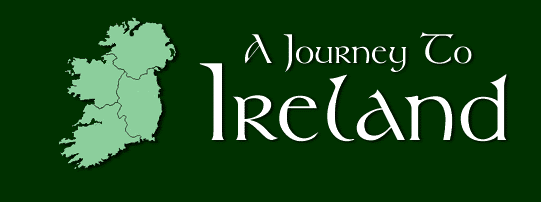
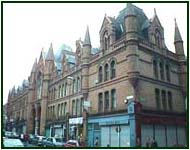
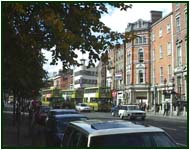
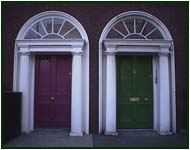
![]()
 In Dublin, all the double-decker buses are green, half the signs are in Gaelic,
and the Guinness ads are everywhere: Guinness For Strength! Guinness Is Good For You!
In Dublin, all the double-decker buses are green, half the signs are in Gaelic,
and the Guinness ads are everywhere: Guinness For Strength! Guinness Is Good For You!
The stately Georgian houses with their famous red, green, yellow, blue, pink, and purple
doors, seem like rows of solemn barristers bursting forth in song.
The irreverent spirit of the town is nicely revealed by a quotation in neon on
the fortress walls of Trinity College:
"I wouldn't give a snap of my two fingers for all their learning."
![]()
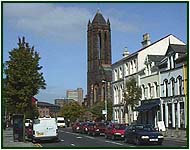
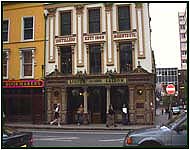
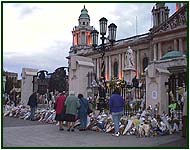
![]()
Most of our time in Belfast was spent at the Public Record Office of Northern Ireland. With the help of the able staff and a remarkable friend I met through this website, Mr. Sean McCartan, Betsy and I were able to pinpoint the house my great great grandfather left 150 years earlier.
Belfast has much in common with my old stomping grounds of Helena, Montana: an excess both of saloons and churches, a roughness which squats amidst the architectual grandeur of an
earlier and more prosperous era, and a small-town resiliancy - tough but friendly. While there we witnessed a remarkable sight: an entire block in front of city hall filled with flowers, poems,
and teddy bears in memory of Princess Diana.
![]()
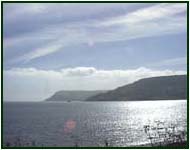
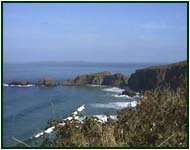
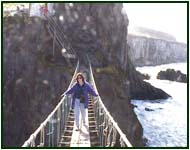
![]()
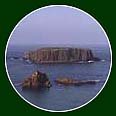 Along the way we paused to chat with the locals at Carnlough and again at the
outskirts of Ballycastle, where the ruins of a 15th century friary doubled as
hole 3 of the local golf course.
Along the way we paused to chat with the locals at Carnlough and again at the
outskirts of Ballycastle, where the ruins of a 15th century friary doubled as
hole 3 of the local golf course.
After lunch we braved the perils of Carrick-A-Rede, a rickety suspension bridge that hangs
80 feet above the jagged rocks and crashing surf of the coast. Although she swore she
wouldn't, Betsy finally traversed the chasm and made it back alive.
![]()
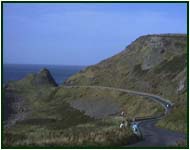
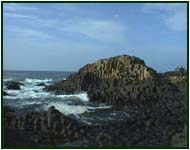
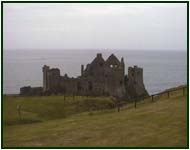
![]()
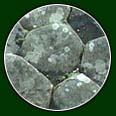 spot volcanic forces somehow caused some 40,000 six-sided basalt columns to rise up
in weird clusters and formations. The hexagonal columns seem too precise to be natural,
thus the legends of a huge causeway built by a giant.
spot volcanic forces somehow caused some 40,000 six-sided basalt columns to rise up
in weird clusters and formations. The hexagonal columns seem too precise to be natural,
thus the legends of a huge causeway built by a giant.
As night closed in we also paused to admire the haunting ruins of Dunluce Castle, the
ruling powerbase of the North Coast for nearly half a century. After this, a warm room
and a good Indian meal in the resort town of PortStewart.
![]()
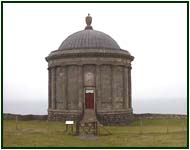
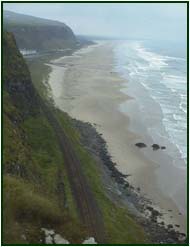
![]()
In the dream-like atmosphere which pervaded this place we were drawn ever closer to the sea.
Here we found the most remarkable sight of all: Mussenden Temple, a circular library perched
on the very edge of the cliff overlooking Benone Strand at the entrance to Lough Foyle.
For me this will remain the center of all the enchantment that is Ireland.
![]()
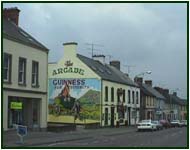
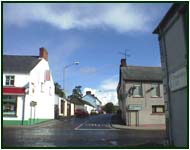
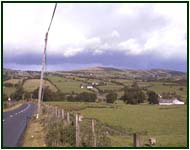
![]()
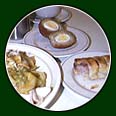 Chicken curry, sausage rolls, a nugget of pure cholesterol called a Scotch Egg,
then on to Claudy.
Chicken curry, sausage rolls, a nugget of pure cholesterol called a Scotch Egg,
then on to Claudy.
For many years I knew only one thing about my Irish ancestors: that they came from a village called Claudy, mysterious as the moon and almost as far away. I never thought I would see it, yet here it was: a cluster of freshly-washed shops around a single intersection. Below that a fine old church and cemetery with several Cartans planted beneath the moss-covered stones. We met Martin Cartin in the pub, friendly Mrs. O'Neill in the general store, and, after some adventures, other Cartan and O'Neill cousins who seemed reluctant to claim us: two American tourists falling out of the sky after 150 years.
Before leaving we climbed the rolling hillside of Gortilea above the village and found
the house and land that was once our family farm. Then, as my ancestor did before me, I
turned my back and headed west.
![]()
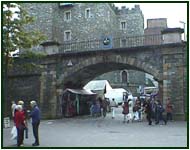
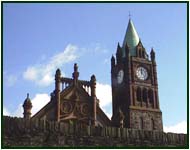
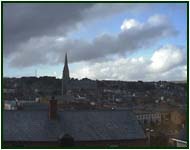
![]()
It is a city steeped in history and still smoldering from grudges long remembered.
The impressive walls of the old town are pierced at regular intervals by
great arched gates. The cobblestone roads lead up a hill and converge at
a stately town square (called "the Diamond"). Some of the tired
brick walls have been painted with passionate political posters, and
occasionally a heavily armoured police car trundles past, but our two days
there were completely peaceful.
![]()
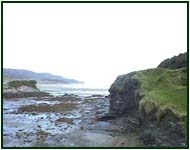
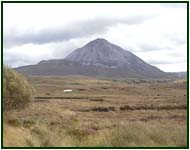
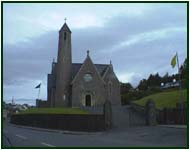
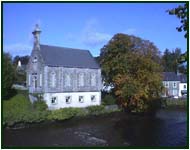
![]()
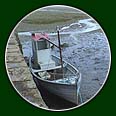 Here Ireland reaches as far north as Alaska reaches south, and the coastline is
shattered into innumerable twisting fingers. Some of the remote villages in the west of
Donegal are completely Gaelic - here even the road signs spoke only in Gaelic.
Here Ireland reaches as far north as Alaska reaches south, and the coastline is
shattered into innumerable twisting fingers. Some of the remote villages in the west of
Donegal are completely Gaelic - here even the road signs spoke only in Gaelic.
We followed the N56 as far north as the fishing village of Dunfanaghy and around the edges of Glenveagh National Park. Along the way we climbed up into high tundra-like country with great swathes of purple heather. We crossed the Gweedore Peninsula with Mount Errigal looming in the distance. After a hearty lunch in Dungloe we continued south along the coast, arriving finally in a magnificent room overlooking the bay in Donegal town.
That night the wind swept across the Atlantic and arrived howling at our door. It
soon became obvious why this place is so famous for its sweaters. The town itself
was as lovely as any we saw, but catered much more to the tourist than any town in
Northern Ireland. We lingered there in the shops, then followed the magnificent coast past
the sleepy grave of Yeats to the town of Sligo, turned eastward, and raced back across the island.
![]()
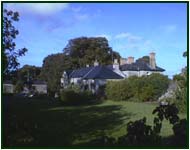
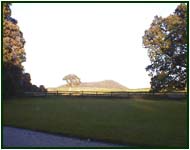
![]()
Ireland, indeed, is the kind of place that lodges in your heart and, like so
many before us, we left vowing to return.
![]()
